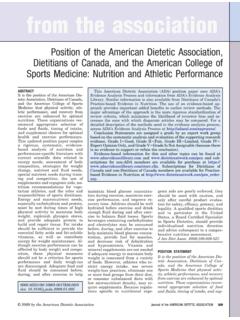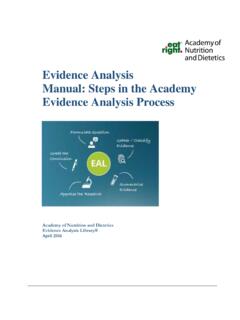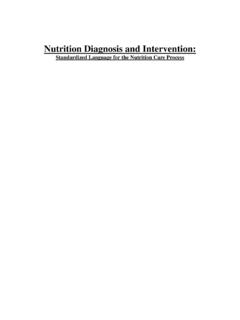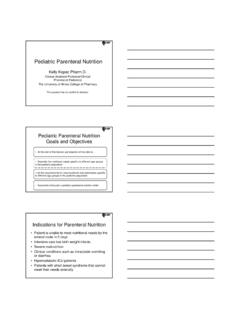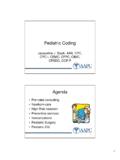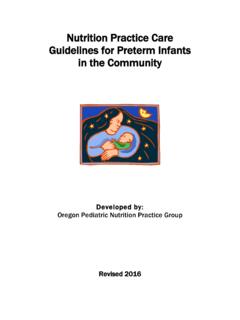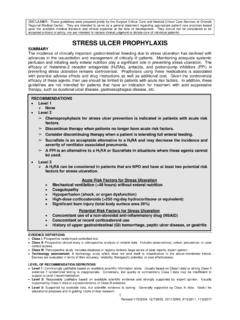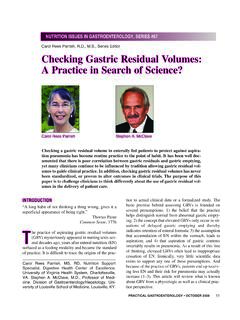Transcription of Applying the Nutrition Care Process: Nutrition Diagnosis ...
1 12 Support LineDecember 2007 Volume 29 No. 6 AbstractThe Nutrition Care Process (NCP)was accepted by the dietetics professionin 2003 and is being implemented in allsettings where dietitians provide directpatient care. Standardized terminologyis being developed to describe theactivities of registered dietitians (RDs)within each of the four steps of the NCP: Nutrition Assessment, NutritionDiagnosis, Nutrition Intervention, andNutrition Monitoring and providing Nutrition support tocomplex or critically ill patients havequestions about how to apply the NCPand standardized language to theirpatients. This article provides a briefoverview of the NCP and a case illus-trating how standardized language canbe applied to a postoperative intensivecare unit (ICU) patient whose coursechanges over NCP is a four-step approach tonutrition problem solving and care thatis designed to guide and illuminate thework of RDs.
2 Since its adoption by thedietetics profession in 2003, three of thefours steps of the process Diagnosis ,intervention, and monitoring andevaluation have been elaborated inbook form (1). Standardized terminol-ogy describing Nutrition Diagnosis wasintroduced in 2005 (2). A second bookthat included Nutrition Diagnosis andintervention terminology was releasedin 2006 (3). A third book, InternationalDietetics and Nutrition TerminologyReference Manual, which includes themonitoring and evaluation step of theNCP, was released in 2007 (4).Many RDs are familiar with the NCP,and some are incorporating standardizedlanguage into medical record documen-tation. As a result, Nutrition supportdietitians have questions about how toapply the NCP to critically ill patientsreceiving enteral (EN) and parenteralnutrition (PN).
3 The dynamic nature ofthe critical care unit and sheer volumeof data that RDs incorporate into thedecision making process presentchallenges in identifying the nutritiondiagnosis, describing the intervention,and determining the monitoring andevaluation using the standardized lan-guage of dietetics. The purpose of thisarticle is to illustrate how the nutritiondiagnosis, intervention, and monitoringsteps of the NCP can be applied to acritically ill patient. BackgroundStandardized or controlled vocabular-ies are used in medicine and nursing todescribe Diagnosis and treatment forthose within and outside the medicalprofession. Examples of controlledvocabularies familiar to dietitians includethe Common Procedure Terminology(CPT) and the International Classifica-tionof Diseases (ICD-9) terminologiesdeveloped for use by physicians (5,6).
4 Nurses may use one of several standard-ized languages, and physical therapistshave also developed a controlledvocabulary to describe their patientcare activities (7,8). All of these termi-nologies ultimately should combine toidentify the contributions of healthprofessionals within the electronicmedical record. The InternationalDietetics and Nutrition Terminology isbeing developed to identify the uniquecontributions of RDs within theuniversal electronic medical record. Controlled vocabularies serve severalimportant purposes besides their rolein meeting the federal mandate forelectronic medical records. The termsand codes are easily incorporated intolaws and regulations. Because they areuniform descriptors, they may facilitateproductivity, efficacy, and reimbursementdata collection.
5 In educational settings,controlled vocabularies are used toorganize information presented tostudents. In the clinical environment,standardized language facilitates clear,consistent documentation of caredelivered, communication betweenhealth-care professionals, and continuityas patients move from one location toanother. Such vocabularies clearlydistinguish the unique activities ofeach profession, thereby reducing theopportunities for miscommunication,overlapping activities, and interprofes-sional conflict. Widespread implementation of theNCP and use of standardized languagealso should aid benchmarking datacollection and may serve as the basisfor identifying homogenous populationsfor research.
6 A standardized approachto describing care is especially valuableto RDs working in Nutrition supportwhere the multifaceted nature of thedata evaluated may be underappreciatedby those who focus on the number ofpatients seen rather than the complexityof care delivered. Nutrition DiagnosisThe most unique feature of the NCPis the Nutrition Diagnosis . The 60nutrition Diagnosis terms and definitionswere developed to describe nutritionproblems that can be treated indepen-dently by the dietitian (4). Thus, theyare distinct from the terms physiciansuse to describe medical , RDs and physicians use asimilar process of diagnostic reasoningto derive diagnoses from their respectivedomains (9). Like medical diagnoses, Nutrition diagnostic terms have a specificdefinition; unique etiologies, signs,and symptoms; and a code numberthat may be used for linking to data inan electronic medical record.
7 Unlikemedical diagnoses, Nutrition diagnosestypically resolve following interventionby the dietitian. Once the RD makes a nutritiondiagnosis, the term is incorporatedinto a Nutrition Diagnosis statement orPES statement composed of three parts:a problem (P), etiology (E), and signsand symptoms (S) (Table 1). WithinApplying the Nutrition Care Process: Nutrition Diagnosis and Intervention Annalynn Skipper, PhD, RD, FADA 13 the PES statement, the Diagnosis is a Nutrition problem that will resolvewith the dietitian s intervention. Theetiology is the root cause of thenutrition problem. It may be improvedor eliminated with the nutritionintervention. The signs and symptomsare monitored by the dietitian to deter-mine progress toward resolving thenutrition Diagnosis .
8 For example, thenutrition support dietitian may calculatethe carbohydrate intake of a criticallyill patient with hyperglycemia, rule out excessive carbohydrate intake as anutrition Diagnosis , and suggest theneed for an increased insulin dose. Diagnosing Nutrition problems andwriting a PES statement that is bothcorrect and meaningful is a rigoroustask. It involves validating assessmentdata, clustering and comparing signsand symptoms to develop differentialdiagnoses, and systematically eliminatingthem until a Diagnosis is derived fromthe signs and symptoms. Nutrition InterventionThe Nutrition intervention is definedas a specific action that remedies anutrition Diagnosis and consists of twocomponents: the plan and the imple-mentation.
9 The first step in planningnutrition intervention is the nutritionprescription. The prescription is basedon best available evidence and theclinical judgment of the RD. It is notthe current Nutrition order, but ratheran individualized statement of the needsof the patient at a given moment intime. In critically ill patients, thenutrition prescription may be adjustedfrequently as medical diagnoses ( ,acute renal failure, hepatic encephalopa-thy), treatments ( , surgical procedures,medications), and the patient s condition( , wound healing, weaning fromthe ventilator) change. An example of a Nutrition prescriptionfor a critically ill patient might be assimple as 1,800 kcal and 65 g might be expanded to include specificamounts of fat, vitamins, minerals,fluids, and bioactive substances.
10 Ideally,the Nutrition prescription is based onthe latest evidence-based standards, butwhere data are lacking, the RD appliesclinical judgment and institutionaltradition to the Nutrition RD implements one of 13nutrition interventions that are designedto reduce the gap between the patient scurrent and ideal intake. Each nutritionintervention consists of a definition, aunique number, and a reference sheetdescribing the details of the interventionand usual application. Nutrition supportdietitians are strongly identified withenteral and parenteral Nutrition (NC-2),which they individualize to meet thenutrition prescription by manipulatingformula volume and support dietitians may alsoprescribe medical food supplements( ) and participate in Nutrition -related medication management (ND-6).



